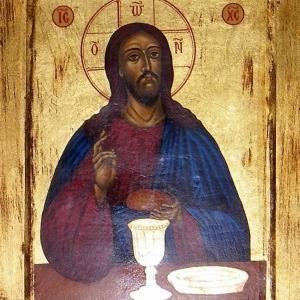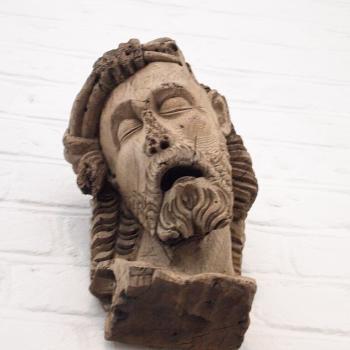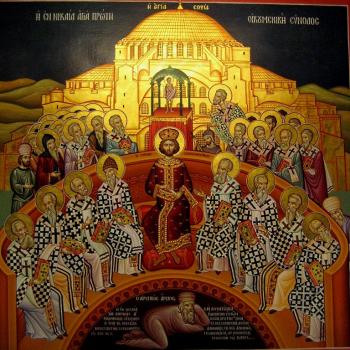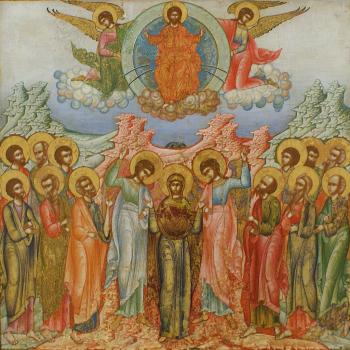
Week after week, month after month, year after year, Catholics partake of the eucharist, knowing that they are receiving Jesus. Sadly, few reflect upon what this means. Many are able to recite catechetical formulations and say that it is the body and blood, soul and divinity of Jesus. Most realize that communion grants them graces which they need. Fewer, however, understand how communion is meant to bring the faithful together as one. Even those who realize this receive it in a simplistic fashion, without trying to meditate on the experience. They ignore the great mystery which lies behind their actions.
An important aspect of the eucharist is that the physical form, the accidents of bread and wine, differs from the reality itself. What is received is not mere bread and wine. Rather, it is Christ himself. But physically, it remains bread and wine. What happens to the physical accidents cannot be said to be what happens to Christ. Thus, when the bread is divided, Christ himself is not likewise divided:
But because the body of Christ is incorruptible, it may truly be said that the breaking and division into parts is done not in the substance of the body, but in the sacramental form itself of the bread, so that there is a true breaking and partition there, which is not done in the substance, but in the sacrament, that is, in the species. [1]
The bread is chewed in the mouth, while Christ remains whole. Likewise, what is received in communion is the whole of Christ, no matter how much of the bread and wine is eaten. There is no greater or less reception of Christ. The sacrament, St. Albert the Great said, is given to us in the form of bread and wine, but the reality is beyond what the senses perceive:
Now it is said commonly that the sacrament alone in this sacrament is the sacramental species, which consists in the accidents of bread and wine. The reality and the sacrament are the body of Christ contained under the species of bread and wine. The reality alone is the grace of spiritual nourishment which per se and principally is brought about in this sacrament.[2]
The reality is Christ. Christ is received – but what happens to the physical aspects of the bread and wine cannot be said to happen to Christ himself. He is not harmed as the bread is eaten; teeth do not impale him. “And so Christ is able to be touched by the teeth in such a way that no kind of pressure from them can wound him any further.”[3] Christ does not suffer when the eucharist is consumed. “For we do indeed believe that the Lord Jesus Christ is truly and salubriously eaten on earth by worthy recipients, and we most certainly hold that he exists in heaven uncontaminated, incorrupt, and unharmed.” [4] This is why eucharistic sacrilege will not cause Christ any harm: he is incorrupt, incapable of being harmed by what is done to the accidents. “For we receive from the sacred altars the flesh of the immaculate Lamb rendered incapable of suffering, through which we both live and are healed from corruption; this flesh can never be corrupted, nor perish, because, although from day to day it renews us, it itself never grows old.”[5]
What does this mean? Is the sacrament an illusion? No, but the physical forms which we receive hide a greater reality beyond the appearances. And yet, we can also speak in accordance to its physicality. Bread is eaten. Wine is drunk. It is not illusory. We do not devour phantom bread and wine. But the reality behind communion shows that what happens when we partake of communion transcends what happens to the physical form of bread and wine. Through communion, we find ourselves taking Jesus into ourselves. Likewise, we are taken into Jesus. We are joined together and made one through the eucharist. Then, in that unity, Jesus gives us deifying grace, the grace needed to be transformed into the body of Christ similar to the way the bread and wine was once transformed into him.
By contemplating this great mystery, then, we can begin to understand why someone like St. Hilary of Poitiers could suggest Jesus truly suffered on the cross without experiencing pain. What happened to the physical form of Christ’s body truly happened. He truly experienced all that happened to him. The event was a real event in history. But the reality of the event transcends what happens to Christ’s physical form. His consciousness, connected to that reality, but also connected to the beatific vision, could be said to lack such pain because of the beatific vision. And this is what happens when the eucharist is consumed: Christ is eaten by us, and yet suffers none of the pain which we would expect if we were eaten alive.
Reflecting upon the eucharist should give us a new perspective on physicality, helping us to see understand why what the senses perceive is real without being the fullness of that reality. The kingdom of God is within us. It remains inviolate. We must connect ourselves to it and when we do so, all things will be made new. We will see and perceive reality in a new way, one which contains but is not limited to the empirical senses. Thus, what St. Albert explained about communion should become not be viewed as some speculative thought about what it can and will help us achieve in the future (or the afterlife), but rather, about what can and should be experienced now:
And so, having clarified these things that pertain to the determination of the truth, playing in this truth, we say that Christ is contained in the sacramental forms as in the place of his glorious dwelling, as in the court of sweetest refreshment, and in the knot of the most loving connection of God and man.[6]
If the eschaton has been revealed to us in Christ, then we should be able to experience the ramifications of the eschaton in our lives. We are meant to receive the eschatological glory in the eucharist:
But it is the bread which descends from heaven, and gives life to the world – the bread that Ambrose and Augustine with the same words call epiousion, that is, “super-substantial,” because the flesh of Christ exists as something greater than all other created substances; it surpasses all other creatures with the most excellent dignity. [7]
Jesus descended from heaven – from the eternity of God – giving us the eschatological truth in and through himself. The eschaton has been immanentized. When we partake of communion, it is this immanentized eschaton which we receive and it is this immanentized eschaton which we should open ourselves up to in order find ourselves a part of the kingdom of God. This is why we pray for the super-substantial bread, the epiousion, as we ask for the realization of God’s will to be done on earth as it is in heaven. The two come together as one in Christ. History should be eschatologized history – that is, it should always be seen as real, that time itself is real, and yet incorporated in the greater transcendent truth of the eschaton. And this is also what lies behind St. Hilary’s understanding of Christ’s passion. It is not a denial of history, but a realization that it is a part of a greater whole.
Thus, as we long for eternal life, we should partake of Christ:
Indeed, the flesh is received by way of the flesh itself, and the blood is received by way of the blood itself, but not without a certain amount of mystery. In another manner of speaking, however, it should be believed, and it can be said, that the whole Christ is eaten – when eternal life, which he is, is longed for with spiritual desire, when the memory of his commands is held in the mind as sweeter than honey from the comb, when fraternal charity, of which this sacrament is a sign, is chosen for the love of Christ, when sweetly and salubriously stored in the memory is the fact that, for the salvation of contumacious men, this has been brought about by hanging upon the cross, by being fastened with nails and wounded by the lance. Both types of eating are necessary, and both are fruitful.[8]
Eternal life is the eschatological life, the life which we can receive and realize right now thanks to the incarnation. Heaven and earth have been bridged. Time and eternity are united. The eschatological reality of Christ is something we are called to participate in. And once we do, we will follow after him, realizing ourselves as the body of Christ. Then we will be the continued presence of Christ in history, suffering like Christ suffered for all the victims of sin. That suffering, however, must be understood similarly to the suffering of Christ. In our actions and deeds for others, we might experience great trials and tribulations, but in our spirit, we should already be receiving some of the joy of the kingdom of God, a joy which helps us transcend any pain associated with such suffering instead of being defined and limited by it. If we seek pain without love, if we seek to suffer by inflicting all kinds of pain and sorrows upon ourselves, we do not yet understand. Pain is never the point of such suffering. Love is. And that love is revealed to us in the eucharist as Jesus opens himself up to us, continuing and fulfilling the eschatological work of the incarnation in us.
[1] Peter Lombard, Then Sentences. Book 4: On the Doctrine of Signs. Trans. Giulio Silano (Toronto: Pontifical Institute of Medieval Studies, 2010), 62 [XII-3].
[2] St. Albert the Great, On the Body of the Lord. Trans. Albert Marie Sumanski, OP (Washington, DC: CUA Press, 2017), 402.
[3] Guitmund of Aversa, On the Truth of the Body and Blood of Christ in the Eucharist in Lanfranc of Canterbury: On the Body and Blood of the Lord & Guitmund of Aversa: On the Truth of the Body and Blood of Christ in the Eucharist. Trans. Mark G. Vaillancourt (Washington, DC: CUA Press, 2009), 102.
[4] Lanfranc of Canterbury, “On the Body and Blood of the Lord” in Lanfranc of Canterbury: On the Body and Blood of the Lord and Guitmund of Aversa: On the Truth of the Body and Blood of Christ in the Eucharist. Trans. Mark G. Vaillancourt (Washington, DC: Catholic University of America Press, 2009), 62.
[5] Guitmund of Aversa, “On the Truth of the Body and Blood of Christ in the Eucharist,” 129.
[6] St. Albert the Great, On the Body of the Lord,242.
[7] Lanfranc of Canterbury, “On the Body and Blood of the Lord,” 47.
[8] Lanfranc of Canterbury, “On the Body and Blood of the Lord,” 58-9.
Stay in touch! Like A Little Bit of Nothing on Facebook.
If you liked what you read, please consider sharing it with your friends and family!













